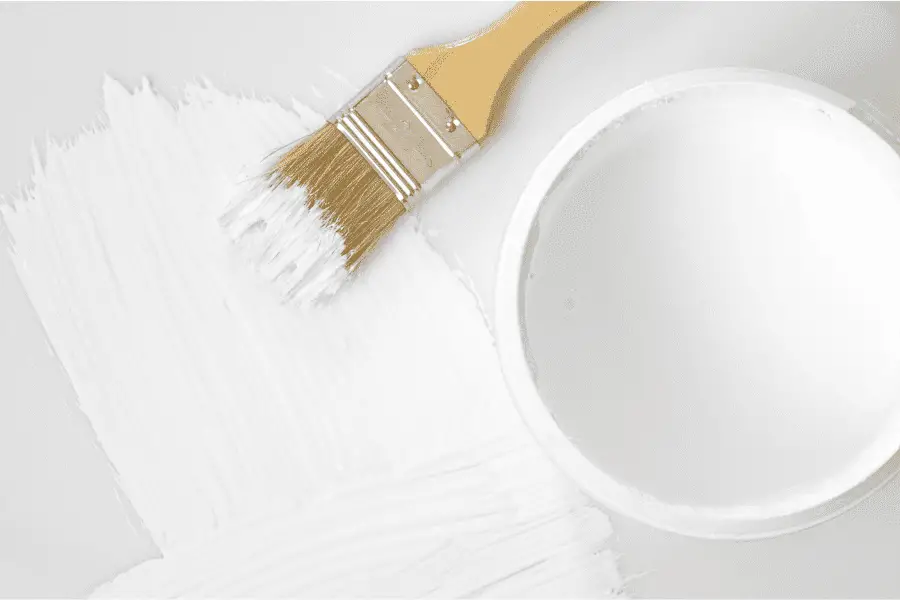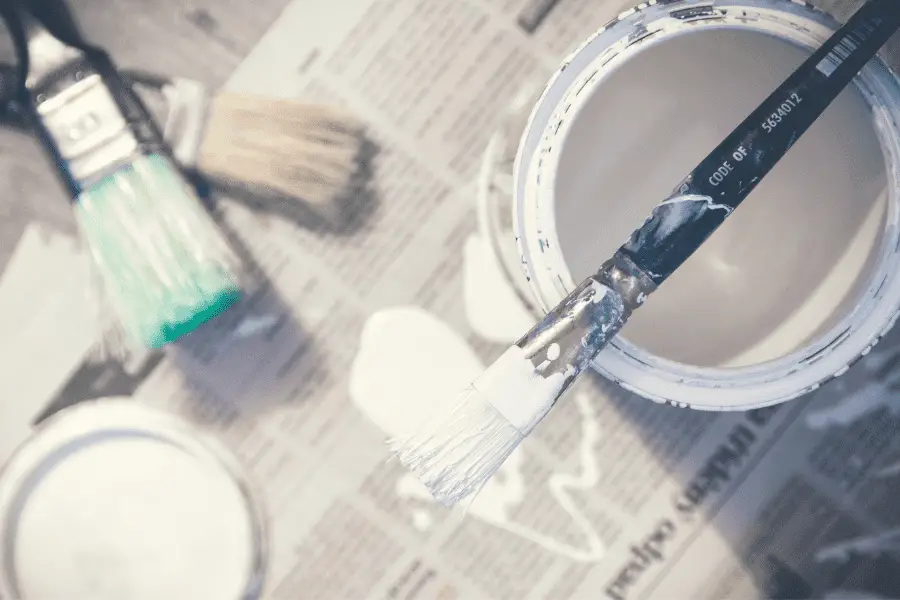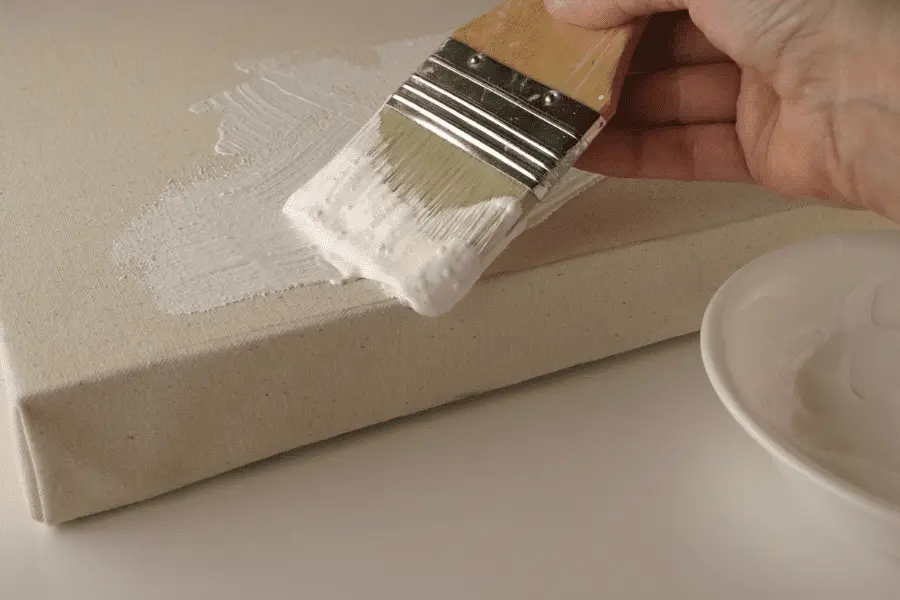Gesso is a familiar tool artists use to prime their canvas for painting. Today’s most gesso is acrylic, allowing the oil in oil paints to sit on top of it easily. While both acrylic paint and gesso are very similar, there are some differences!
So, can you mix gesso with acrylic paint? Yes, you can mix gesso with acrylic paints. However, these two materials have different finishes. Gesso is matte, and acrylic is glossy, so you’ll have a primer layer between the two finishes. Gesso is also a lot thinner than acrylic and not as stiff, so you’ll notice some differences in the texture on your canvas.
Overall, you can mix the two easily! Some artists do this to add different textures or colors to their work. If you’re interested, you’ll want to keep reading so you can try it too!
How To Mix Gesso With Acrylic Paint

Since gesso is traditionally plain white, mixing it with acrylic paints is a great way to add more color to the base of your painting. You can add color by simply mixing a small amount of acrylic paint with the gesso.
You’ll want to add a few drops of water, then use a mixing tool (not a paintbrush) to stir your mixture. The water makes blending easier for the two different materials since they’re water-soluble.
I recommend using a palette knife to mix your gesso and acrylic paint.

Since gesso is white, it should be very easy to see tints of new color in it from the acrylic paint! You can make adjustments as needed until you get the gesso to the shade you want.
If you want to thin your acrylics, you can add gesso to them. Stir the combination on your palette with your knife and continue adding more until you get your preferred consistency and shade.
In short, mixing these two different art materials isn’t hard. You’ll have an easier time mixing it yourself because you can see how the shade of the gesso changes in real-time!
Can You Mix Clear Gesso With Acrylic Paint?

Gesso isn’t always white- you might also find clear options! Clear gesso is also great for combining with acrylics. Since it’s not white, the color of the paint won’t change. If you want a bright, vibrant pigment for your gesso, using a clear base is the best way to start!
However, you’ll want first to understand that these two art materials dry into different finishes. Gesso tends to have a matte finish, while acrylics are shinier. If you mix the two, the final result won’t be fully matte or full gloss. You’ll have something in between!
You can experiment with various ratios of acrylic paints and gesso. When you find a texture and consistency that you want, it’s a good idea to note it for later if you want to mix more.

Did you know there’s also black gesso? It’s perfect for creating unique textures and backgrounds on your canvas.
How Long Does It Take for Gesso To Dry?

Gesso doesn’t take very long to dry. When you apply a thin coat, it should only take twenty minutes at most to harden completely. However, you’ll want to add a second coat of gesso, then wait at least 24 hours.
Because of this, many artists like to prepare their canvases with gesso in advance. You can prepare several canvases as well to help stay on task.
If you’re using acrylic paint combined with gesso, keep in mind that it can take longer to dry! Acrylic paints dry quickly, but gesso tends to dry much faster because it’s thinner. You won’t want to smear your pigmented gesso, so you should let it dry for at least 24 hours.

Although, if you can prepare your canvases in advance, you should try to give them longer to dry. You won’t have to stress about ruining the gesso layer while you paint. Overall, gesso dries fast, but you should give it as much time as possible before painting over it.
As long as you stir the gesso and acrylic paint together well, they should dry together without problems.
How Do You Use Gesso With Acrylic Paint?

The best method to apply gesso involves using a wide, square, flat brush. The bigger the brush, the faster you can cover the canvas with gesso! If you have a particularly large canvas surface to cover, you should use a larger brush.

Start by shaking your gesso can to stir it, then open it up. Next, dip the brush into the gesso and cover the entire surface of the canvas using brush strokes in a single direction. Allow the gesso to sit for at least 20 minutes, then apply another coat of gesso.
You’ll want to make sure your brush strokes go the opposite direction for the second coat. For example, if you used horizontal strokes the first time, apply the second coat using vertical strokes! In doing so, your brush marks won’t show up as drastically through the paint.
You can apply your pigmented gesso in the same way! It may add more texture and change your gesso’s finish, but you can always implement those as features to the artwork.
Gesso acts as a primer for you to put paint over. It can still serve the same purpose when you add acrylics to it. However, you might find some other creative ways to use it.
Is Gesso Necessary for Acrylic Painting?

You don’t need to use gesso in your acrylic paintings; it’s more for use in oil paintings. Oil paints can damage the canvas, so you want to prime it with gesso. Plus, it makes it easier to apply the oil paint.
While it’s unnecessary to use gesso for acrylics, you still can. Some artists do this because they want to remove the appearance of the canvas from their painting. Although acrylic paint won’t harm the canvas as oils do, you can paint directly on it if you want to!
Overall, gesso isn’t necessary for acrylic painting- but you can still use it. It’s best when you don’t want to paint directly on the canvas or you want to make your painting look a specific way.
Can I Use Gesso Instead of White Acrylic Paint?

Gesso and acrylics are similar enough that you can use gesso instead of white paint in your work. However, it will be more noticeable. Since gesso is thinner, it won’t look the same as white paint when it dries.
Dried gesso is hard and very textured, unlike typical white acrylic paint. If you don’t mind the matte finish appearing in your painting, you can use gesso as a stand-in for acrylic paint without worry.
Both of these materials are water-based, which means they can combine easily. You can’t mix oil paints with gesso, however. Oil paints tend to separate from the water-based gesso, making the mixture chunky.
Final Thoughts
In short, you can mix gesso with acrylic paint! The two materials are extremely similar, so they combine well. You won’t want to do this with oil paint as the two will separate on your canvas, giving you bad results.
Overall, there are many ways to use pigmented gesso in your paintings. You’re sure to come up with some uses for it! It’s also very easy to do. You need to add a little water to your mixture to make it easier to blend the two different materials well.
Make sure to follow all my tips and recommended products to ensure your project turns out great! Also, don’t forget to check out my other articles for all your painting Q&A’s. Happy painting!

